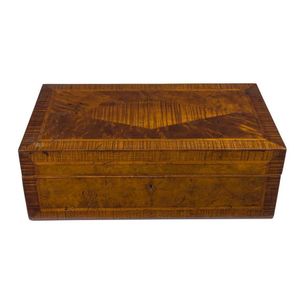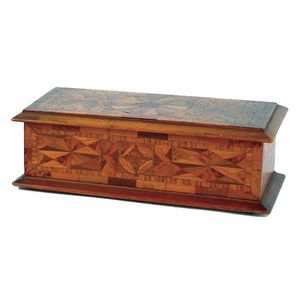Early 20th Century Birds Eye Maple Jewellery Casket
You must be a subscriber, and be logged in to view price and dealer details.
Subscribe Now to view actual auction price for this item
When you subscribe, you have the option of setting the currency in which to display prices to $Au, $US, $NZ or Stg.
- Maple - Maple, native to North America, is a dense heavy timber from light to yellow-brown in colour. It has very little distincive graining unless it is one of the variants such as birds-eye maple or burr maple, so was not used extensively for furniture in 18th and 19th century, where cabinetmakers and designers preferred timbers with more distinctive features such as mahogany, walnut, rosewood and oak.
Birds-eye maple has a seres of small spots linked by undulating lines in the grain, is highly sough and is used as a decorative veneer. Burr maple has larger and irregular grain swirls than birds-eye maple. - Bird's Eye Maple - Bird's eye maple is a type of wood that is characterized by its unique, small, round eyes or spots that are scattered throughout the wood. These spots are caused by a genetic defect in the tree, and they give the wood a distinctive, swirling pattern that is highly sought after by woodworkers and furniture makers.
Bird's eye maple is harvested from the hard maple tree, which is native to Northern Europe and North America. The wood is generally pale in colour, with shades of cream, white, or light brown. The bird's eye figure is most seen in hard maple, but it can also be found in other species of maple such as the big leaf maple and silver maple, but hard maple is the most common.
It became fashionable in furniture manufacturing for use as a decorative veneer from the late 18th century to the late 19th century.
As well as furniture making, it is also used in musical instruments such as guitar, drums, and pianos and smaller decorative items such as various type of boxes such as tea caddies and in picture frames.
This item has been included into following indexes:
Visually similar items

A Tasmanian writing slope box, fiddleback blackwood, musk and huon pine stringing, circa 1840, 16 cm high, 46.5 cm wide, 26 cm deep

A traveling cash drawer, interior fitted and labelled for pre-decimal currency, circa 1900 A travelling cash drawer, interior fitted and labelled for pre-decimal currency, circa 1900 15 cm high, 34 cm wide, 30 cm deep

A good New Zealand woods colonial inlaid trinket box, rectangular form, all-over geometric inlays of various woods, the lid with a star enclosed within a circle flanked by matching panels, this similar design repeated to all sides, raised on small button f

An antique American oak trunk, original lining paper depicting American scenes, condition: original lock and hinges intact, restored condition, 35 x 83 x 54.5 cm
